Meet the Monstera plant, the elegant indoor beauty that’s graced countless living rooms and offices with its breathtaking foliage. If you’ve ever admired its large, glossy leaves and unique split patterns, you’re not alone.
But here’s the thing – for your Monstera to flourish, it needs the right potting soil.
Think of this potting soil mix as your plant’s home. Just like we thrive in comfortable environments, Monstera plants do too.
But what’s the best soil for Monstera? This question confuses many!
It’s not rocket science, but there are a few things you need to know regarding the Monstera soil mix recipe. In this article, we’re going to dive into the world of the best soil mix for your Monstera plant.
So, without further ado, let’s begin!
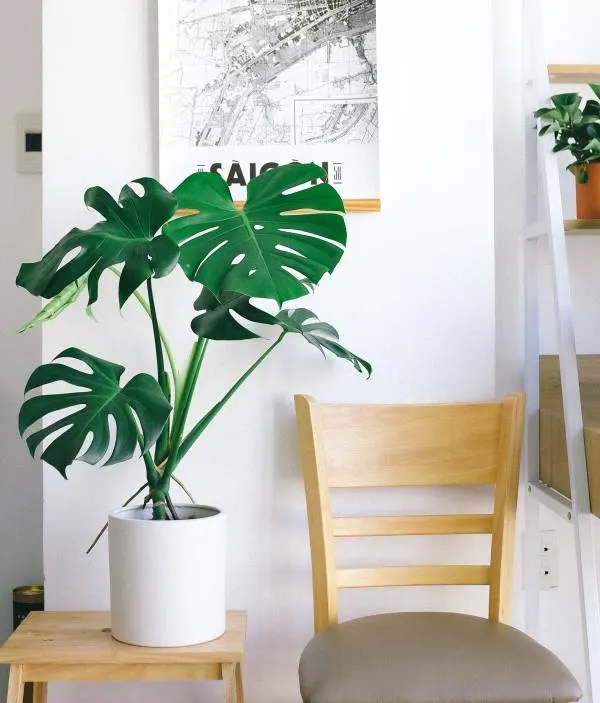
Best Soil for Monstera Plant!
Your Monstera’s success story starts with choosing well-draining soil and the right potting soil mix.
A different Monstera soil mix recipe will have different characteristics than other types of Monstera potting soil mix, and understanding all of these potting soils is essential for your plant’s well-being.
Here, we’ll explore three common soil mixes for Monstera and help you pick the perfect one for your leafy friend.
Peat-Based Mixes
Peat-based mixes are like cozy blankets for your Monstera plant.
They often consist of sphagnum peat moss, perlite, and other organic matter. Peat moss retains soil moisture well, while perlite keeps the potting mix airy.
This combo provides a balanced environment for your Monstera’s roots.
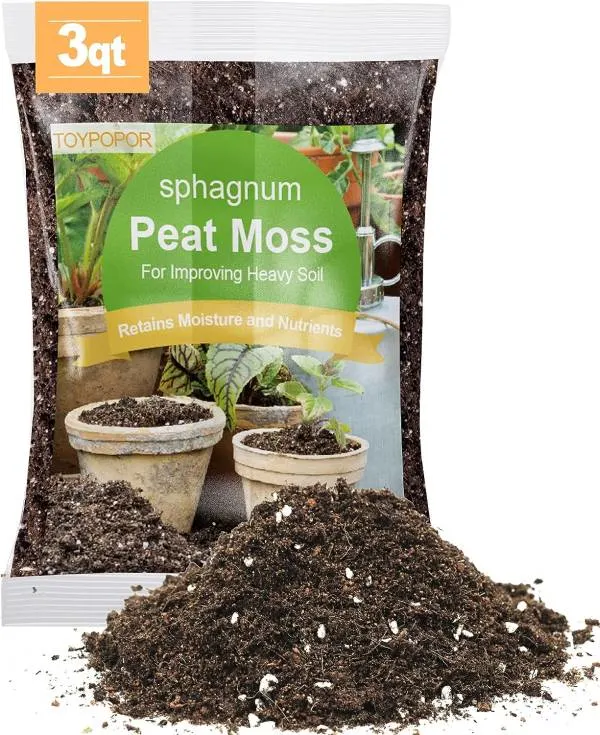
Benefits:
Excellent water retention, reducing the frequency of watering.
Adequate aeration for root health.
Suitable for your Monstera plant if you tend to forget to water occasionally.
Drawbacks:
Overwatering can be an issue, leading to root rot.
Over time, peat moss can break down and become less effective.
Peat-based mixes can be a great choice for your Monstera plant, but it’s essential to monitor your watering habits to ensure their continued health.
Coconut Coir Mixes
Coco coir mixes are like a breath of fresh air for your Monstera.
They’re made from coconut husk fibers, offering an eco-friendly alternative. Coconut coir also has great water retention and aeration qualities, making it a strong contender for Monstera soil.
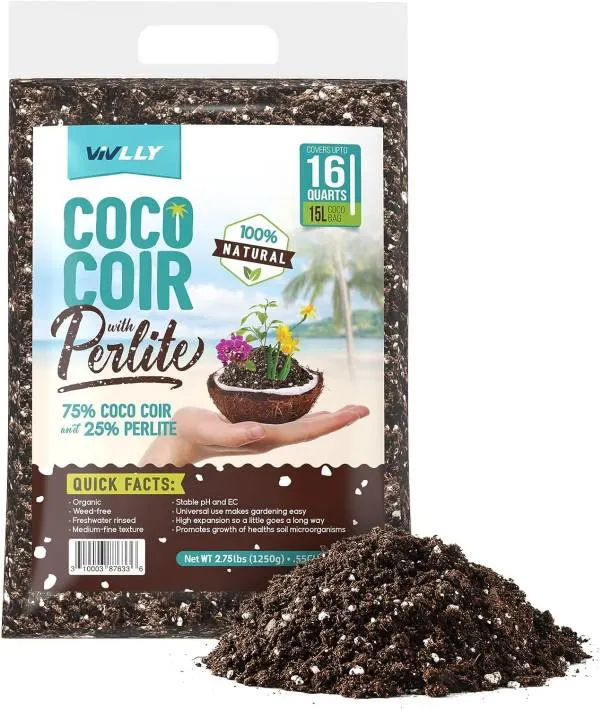
Benefits:
Retain moisture well while allowing excess water to drain.
Environmentally friendly and sustainable.
Ideal for those who want a soil mix that balances moisture and aeration.
Drawbacks:
It may require more frequent watering compared to peat-based mixes.
Coconut coir can sometimes compact over time, reducing aeration.
Coco coir mixes provide a breath of fresh air for your Monstera plant, offering a sustainable and balanced soil option.
Perlite and Vermiculite Mixes
Perlite and vermiculite mixes are like a Monstera’s spa day.
These mixes usually combine potting soil with perlite and vermiculite.
Perlite provides aeration, while vermiculite retains moisture, creating a harmonious blend for your Monstera.
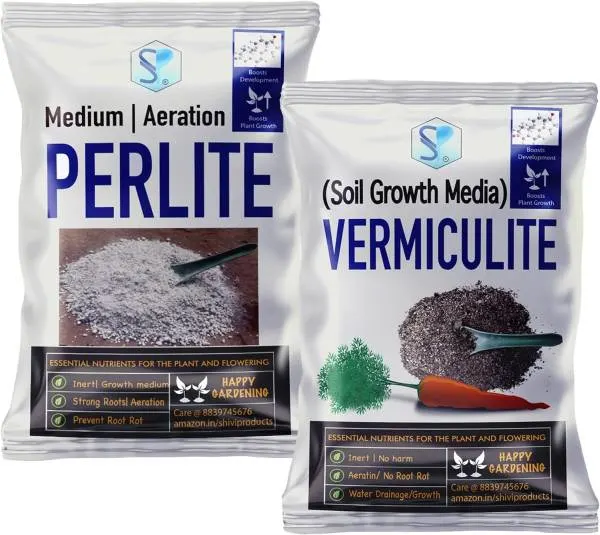
Benefits:
Well-draining potting mix, preventing overwatering.
Good water retention without waterlogging, maintaining the soil moisture.
It is ideal for those who want a precise moisture control potting mix.
Drawbacks:
It may require more attention to watering frequency.
Limited organic matter means fewer nutrients in the mix.
Perlite and vermiculite mixes offer your Monstera plants a good experience, with superb drainage and moisture retention for precise watering control.
What Monstera Plants Need in Potting Soil?
Monstera, scientifically named Monstera deliciosa, have specific soil requirements that offer unique growth habits and needs.
These plants do best in soil that drains well and has plenty of air, just like the soil in the rainforests where they come from.
Apart from that, Monstera plants need the following components in their potting soil:
Good Drainage
To make your Monstera thrive, think of its home as a tropical paradise.
Just like in those warm places, the ground stays moist for a long time, but the topsoil dries out quickly because of the hot weather. To replicate that kind of environment you need to make a Monstera soil mix recipe that has good drainage.
When you are taking care of them at home, wait until the top inch or two of the soil feels dry to the touch before giving them a refreshing drink of water. Also, make sure your plant pots have a good number of drainage holes at the bottom.
It’s like giving your plant a little piece of the tropics right at home!
Consistent Moisture
Monstera plants, also known as Swiss cheese plants, are like nature’s puzzle pieces with unique holey leaves that are simply captivating.
If you want to keep these beauties happy, here’s a secret: They are like Goldilocks regarding their soil moisture levels – not too dry, not too wet, just right.
To achieve this perfect balance, mix some peat moss or perlite in your Monstera soil mix.
It’s like a magic trick that helps the soil to hold onto the moisture without becoming a soggy mess.
Nutrient-Rich Conditions
Monstera plants are true adventurers, always on the hunt for treasure in the top layer of the soil.
They have a hearty appetite for nutrients, especially when they’re sprouting those gorgeous, lush green leaves. To make your Monstera thrive, you can treat it with some homemade compost blended into its potting mix.
Also, don’t forget to feed it some plant food during the sunny seasons of spring and summer, either every two weeks or once a month.
Signs Your Monstera Is Planted in the Wrong Soil!
When your cherished Swiss cheese plants start fading in color or drooping sadly, it’s their SOS!
Let’s investigate the Monstera potting mix and understand the reason behind your green companion’s distress.
Monstera plants speak through their leaves; listen closely by inspecting the soil, and you’ll nurture them back to their vibrant life.
Yellow Spots
Monstera plants are native to rainforests, so they like to stay well-hydrated.
But here’s the twist: Too much water can stress them out just as much as too little. If you spot those leaves turning yellow, it’s time for a check-up.
Grab a stick or a moisture probe and poke the soil from the top down.
Is the soil too wet?
If yes, your plant might be in need of a little soil makeover with some sand, clay, or bark to help water flow better.
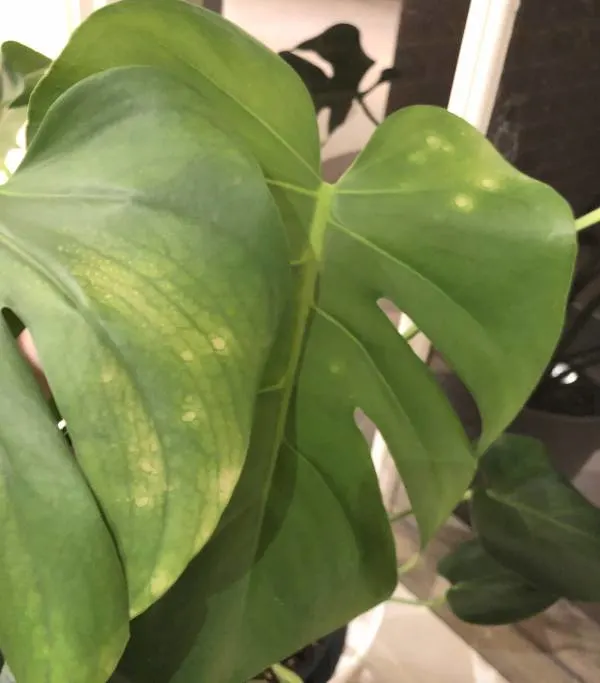
Brown Spots
If you’ve ever had the pleasure of caring for a Monstera plant, you know that its lush, vibrant leaves are a sight to behold.
However, sometimes those leaves develop mysterious brown spots that can leave any plant parent concerned.
These unsightly marks are often the result of a silent but disturbing criminal: Root rot!
Root rot, like a silent villain, tends to strike beneath the surface, damaging the plant’s roots before it reveals itself on the leaves.
But fear not!
There is a telltale root rot sign to watch out for – a foul, unmistakable odor that precedes the appearance of brown spots.
In order to protect your Monstera’s leafy beauty from root rot, make sure you’re not leaving your plant’s roots submerged in waterlogged soil.

Drooping Leaves
When your plant’s leaves start to droop, it’s usually because they’re feeling thirsty.
So, first things first, check the soil.
Stick your finger in there and see if it’s dry soil.
If it is, don’t fret; you just need to add some moist organic stuff to make it happy again. But don’t go overboard with things like bark and sand – they’re not big fans of water.
Now, if your Swiss cheese plant is still drooping even after a good drink, it might be craving some nutrients or has a wrong pH level.
No worries, just grab yourself a soil test kit to figure out what’s cooking beneath the surface.
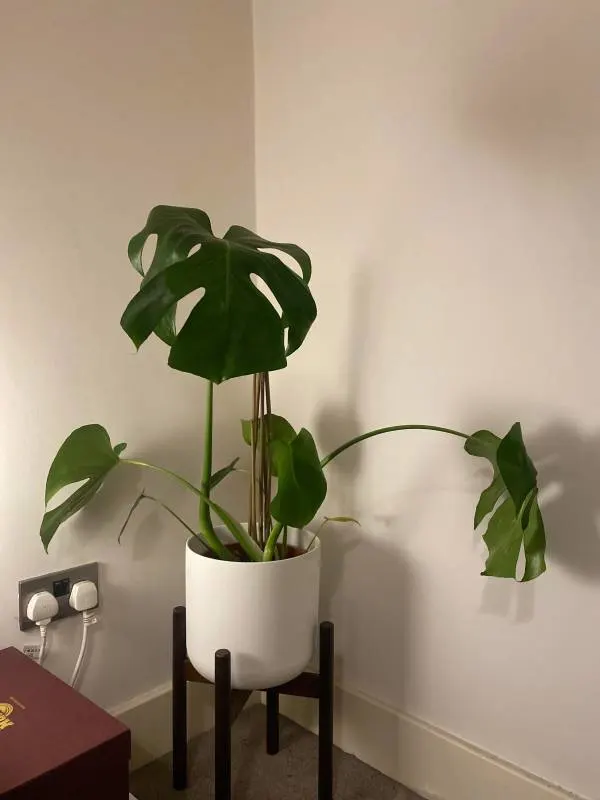
How to Make the Best Soil for Monstera Plants?
Achieving thriving Monstera plants is about the perfect recipe for soil and care.
Creating a nourishing soil mixture using:
Organic potting soil
Perlite for drainage
Orchid bark for structure, and
Sphagnum peat moss for moisture retention
This custom mix is just like the lush rainforest soil Monstera deliciosa adores. Add a touch of sand or Leca pebbles for extra drainage in larger pots while steering clear of compacted soil.
But it doesn’t stop there!
To make your Monstera flourish, remember the monthly fertilizer ritual during the warm, bright seasons and adjust to bi-monthly feedings in the cooler months.
These nutrients replicate the thriving rainforest ecosystem, ensuring your indoor Monstera remains healthy and vibrant even when the sunlight dips.
So, with your green thumb and this carefully crafted recipe, your Swiss cheese plant will flourish as if it never left its tropical habitat.
Commercially Available Soil Mix for Monstera!
When it comes to caring for your Monstera plant, having the right potting mixture is essential for its health and growth.
While you can certainly create a custom Monstera soil mix recipe, as discussed earlier, many commercially available soil mixes cater specifically to the needs of Monstera deliciosa.
These pre-packaged blends offer convenience and peace of mind, ensuring your beloved plant receives the ideal combination of nutrients, drainage, and moisture retention.
Miracle-Gro: Potting Mix for Indoor Plants
To keep your Monstera thriving indoors, Miracle-Gro has just the blend you need.
They offer a range of potting mixes suitable for various plants, making it a versatile choice for indoor gardeners.
Look for their potting mix specifically crafted for indoor plants or foliage plants, such as Monstera.
These mixes are carefully formulated to provide essential nutrients that promote healthy leaf development and robust root growth.
Apart from that, they also strike a perfect balance by retaining the right amount of moisture to keep your Monstera hydrated.
Fox Farm | Ocean Forest and Happy Frog!
Fox Farm offers not one but two exceptional options:
Ocean Forest Potting Mixes
Happy Frog Potting Mixes
Both are adored by Monstera enthusiasts worldwide.
Let’s discuss both of these variation in detail.
Ocean Forest Potting Mix
Ocean Forest is a premium blend known for its exceptional quality.
Packed with bat guano, earthworm, worm castings, and fish meal, it offers your Monstera a feast of nutrients.
As Monsteras love to grow in slightly acidic soil, Ocean Forest maintains a soil pH level that falls within the range preferred by Monstera plants, promoting robust growth.
It ensures proper aeration and drainage, reducing the risk of overwatering.
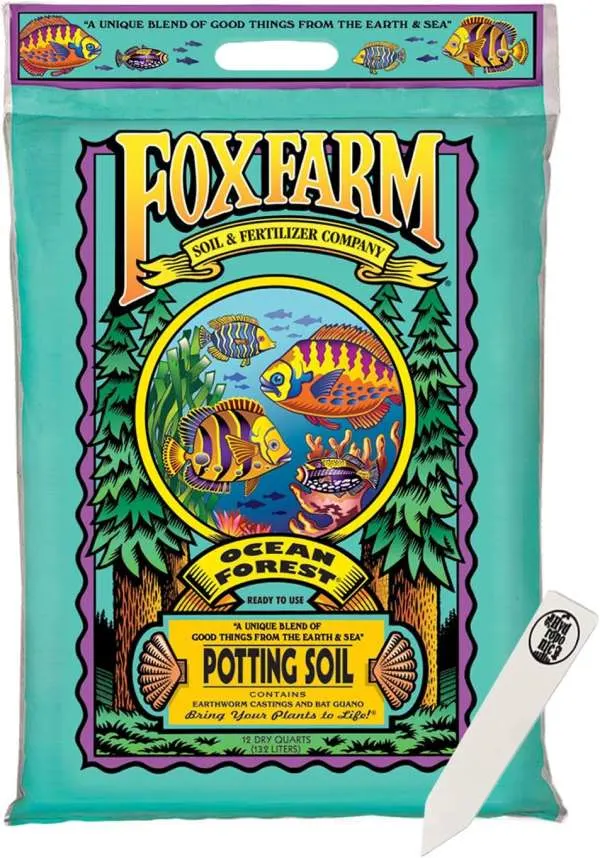
Happy Frog Potting Mix
Happy Frog is an organic potting mix, perfect for gardeners who prioritize organic gardening.
Enriched with beneficial soil microbes plant roots and mycorrhizae, it fosters a healthy and symbiotic relationship between your Monstera’s roots and the soil.
This mix retains moisture, ensuring your Monstera stays hydrated between waterings.
Whether you’re potting or repotting your Monstera, Happy Frog is a fantastic choice.
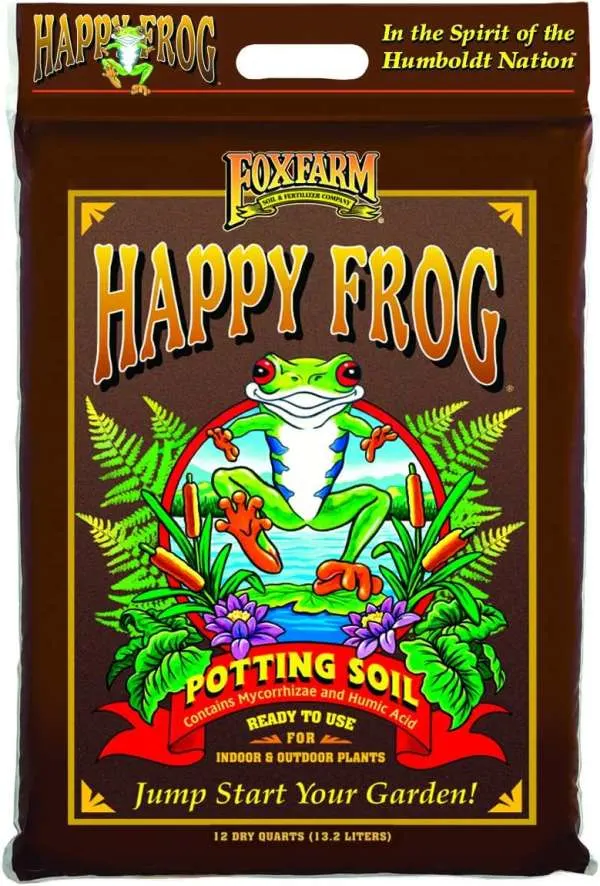
DIY vs. Commercial Soil Mixes
When it comes to choosing the best soil mix for your beloved Monstera plants, you have two main options: making your own mix or opting for a commercial one.
Each has its own set of advantages and drawbacks, and it’s essential to understand them before you decide which route to take.
Making Your Own Monstera Soil Mix
Let’s discuss both the pros and cons of homemade potting mix first.
Pros:
Creating your own mix allows you to modify it precisely to your Monstera’s needs. You can adjust the components to match your plant’s preferences for moisture, aeration, and nutrient levels.
Buying individual components in bulk can be cost-effective in the long run, especially if you have several plants with varying requirements.
Cons:
DIY soil mixes require some knowledge of different soil components and their ratios. It might be overwhelming for beginners.
Preparing your mix from scratch can be time-consuming and may involve trial and error to find the right blend.
If not mixed correctly, DIY soil can be inconsistent, leading to uneven plant growth or health issues.
Homemade potting mix allows you to have complete control over the quality and source of the components, ensuring a healthier and more sustainable environment for your Monstera.
Commercial Monstera Soil Mixes
If you don’t want to make any effort or don’t want to make any irregular mixture of different compounds, you can go with commercially available Monstera soil mixes.
But they have their own pros and cons.
Let’s discuss them in detail as well.
Pros:
Commercial mixes are ready to use right out of the bag, saving you time and effort.
They’re hassle-free for both beginners and experienced plant parents.
Reputable commercial mixes are carefully formulated to provide optimal conditions for Monstera plants. They often undergo quality control to ensure consistency.
Cons:
Commercial mixes may not perfectly match your Monstera’s specific requirements, and customization options are limited.
Ready-made mixes can be more expensive upfront compared to DIY alternatives.
Using commercial mixes often comes with consistent texture and particle size, which can help maintain proper aeration and water distribution in your Monstera’s pot.
That’s all!
Let’s move toward the conclusion and summarize the talk here.
To Sum Up!
The key to nurturing a thriving Monstera lies in understanding its soil needs and providing it with the right environment.
Just as we seek comfort in our homes, Monstera plants flourish when they are given a soil mix that mimics the tropical paradise they originate from.
Whether you opt for peat-based mixes, eco-friendly coco coir blends, or precise perlite and vermiculite combinations, choosing the right soil depends on your care routine and the plant’s preferences.
Remember, healthy soil means a vibrant Swiss cheese plant!
Pay attention to signs that your plant might be unhappy with its soil, such as yellow or brown spots or drooping leaves, and take the necessary steps to remedy the situation.
Whether you prefer crafting your custom soil mix or opting for commercial alternatives, providing your Monstera with the ideal soil conditions is the foundation for a lush and thriving indoor oasis.
With the right soil and care, your Monstera will flourish as if it never left its tropical habitat.
Regards,
Moiz Atiq.
